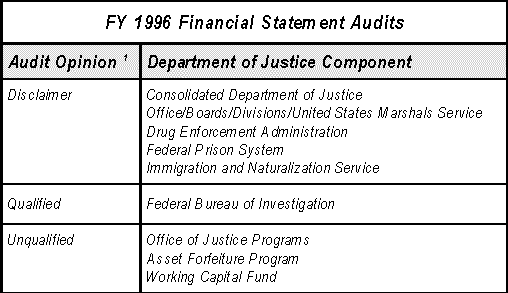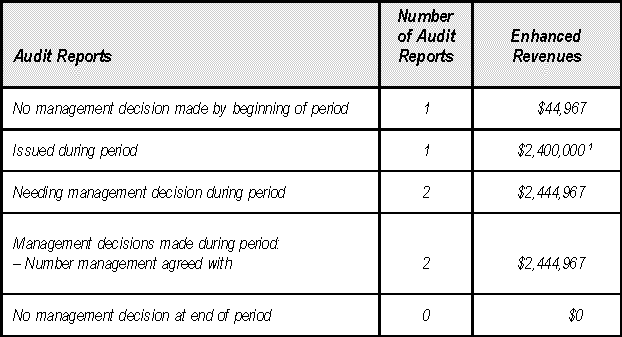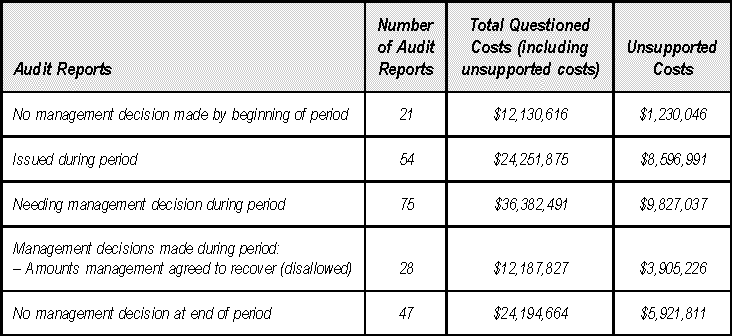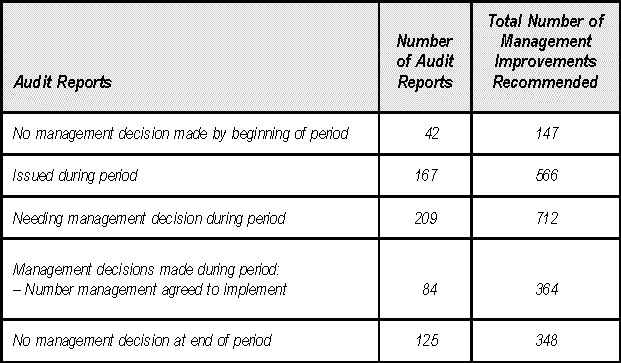
USDOJ/OIG - Semiannual Report to Congress, April 1, 1997 - September 30, 1997 |
Page 16 |
The Audit DivisionThe Audit Division is responsible for independent reviews of Department of Justice organizations, programs, functions, computer technology and security systems, and financial statement audits. |
USDOJ/OIG - Semiannual Report to Congress, April 1, 1997 - September 30, 1997 |
Page 17 |
The Audit Division is responsible for independent audits and related reviews of Department of Justice (Department) organizations, programs, functions, computer technology and security systems, and financial statement audits. The Audit Division also conducts or oversees external audits of expenditures made under Department contracts, grants, and other agreements. Audits are conducted in accordance with the Comptroller General's Government Auditing Standards and related professional auditing standards. The Audit Division produces a wide variety of audit products designed to provide timely notification to Department management of issues needing attention and assists the Investigations Division in complex fraud cases.
The Audit Division works closely with Department management in developing recommendations for corrective actions that will resolve identified weaknesses. By doing so, the Audit Division remains responsive to its customers and promotes more efficient and effective Department operations. During the course of regularly scheduled audit work, the Audit Division also lends fiscal and programmatic expertise to Department clients.
During this period, the Audit Division issued 21 internal reports of programs funded at
almost $18 billion, 35 external reports of contracts, grants, and other agreements funded
at over $200 million, 114 audits of bankruptcy trustees with responsibility for funds of
over $170 million, and 457 Single Audit Act audits encompassing almost $524 million. The
Division issued three Management Information Memoranda, one Technical Assistance
Memorandum, and six Notifications of Irregularity.
Management of the FBI's Safe Streets Fugitive Task Forces
The Federal Bureau of Investigation's (FBI) Safe Streets Violent Crime initiative was organized to allow FBI offices to establish long-term, proactive task forces that focus on violent crimes and the apprehension of fugitives who commit those crimes. While the task forces are funded and sponsored by FBI, membership includes state and local law enforcement officers and other federal law enforcement personnel. Total Fiscal Year (FY) 1995 operating costs were $112.5 million, or 5.3 percent of the FBI's budget for that year. As of April 1996, FBI had established 141 task forces, of which 64 concentrated on locating and apprehending violent state and local fugitives.
Our audit revealed that FBI could put about $3.7 million to better use. Seven of twenty fugitive task forces we reviewed exhibited operational weaknesses and should be reorganized or redirected. Specifically, the task forces in Charlotte, North Carolina, and Mobile, Alabama, had low numbers of arrests; El Paso, Texas, and Kansas City, Missouri, lacked direct FBI supervision; Sacramento, California, and San Juan, Puerto Rico, had limited participation from state and local members; and Tampa, Florida, handled cases that could have been managed locally.
USDOJ/OIG - Semiannual Report to Congress, April 1, 1997 - September 30, 1997 |
Page 18 |
Significant Audit Products
As part of our audit, we collected and analyzed National Crime Information Center data on persons wanted for violent crimes in the United States. Further, we used mapping software to determine if FBI could use that information to help position task forces. Our audit concluded that FBI did not periodically assess whether task forces were properly situated where the number of warrants for violent crimes was highest, or evaluate the degree of participation and cooperation by member agencies. We recommended that the locations and activities of the task forces be more efficiently located and monitored.
Computer Security at the Department of Justice
Computer security continues to be a material management issue for the Department. This report summarized findings that have appeared in eight prior computer security audits completed between FYs 1993 and 1997 and concluded that the Department's computer security program was not effective.
The audit report is not publicly available because of the sensitivity of some items discussed in the report, the detailed disclosure of which could compromise the data contained in the Department's computer systems.
INS Immigration User Fee Remittances
The Immigration and Naturalization Service (INS) collects a fee from each international traveler entering the United States. This fee is primarily used to fund immigration inspection and detention services at air and sea ports-of-entry. The fees are collected by the commercial air and sea carriers and travel agencies. Fees are then remitted to INS on a quarterly basis as required by law.
Based on FYs 1995 and 1996 figures, our audit determined that the U.S. Treasury could average enhanced revenues of at least $1 million per year from interest savings if immigration user fee collections were remitted to the government monthly rather than quarterly. The U.S. Customs Service (Customs) and Department of Agriculture's Animal and Plant Health Inspection Service (APHIS) also collect user fees similar to INS fees. If fees collected by these agencies were also remitted monthly rather than quarterly, the U.S. Treasury could average an additional $1.4 million per year in enhanced revenue from interest savings.
We recommended to INS, and they agreed, to:
· Initiate changes to the immigration user fee legislation to require that immigration user fee collections be remitted to INS on at least a monthly basis and maintained in a separate escrow account segregated from collectors' operating accounts.
· Coordinate with Customs and APHIS on initiating the recommended legislative change to all three fees.
· Establish a task force with Customs and APHIS designed to improve the remittance of user fee collections and to share common findings.
USDOJ/OIG - Semiannual Report to Congress, April 1, 1997 - September 30, 1997 |
Page 19 |
Significant Audit Products
USMS Management of Property and Capitalized Assets
The U.S. Marshals Service's (USMS) enforcement of federal laws and the support services it provides to the federal judicial system depend on an infrastructure of equipment and property that should be safeguarded against waste, loss, unauthorized use, and misappropriation. Overall, our audit found that USMS cannot depend on its property management system because it does not adequately record, manage, or control personal property in USMS. Our audit sampled all types of USMS property; however, the most serious problems involved computer equipment.
Specifically, our audit found that:
· At least 2,776 items of USMS property, worth almost $3.5 million, could not be located, and a disproportionate share of that property was assigned to USMS Headquarters offices.
· At least 5,070 items of property, worth over $4 million, were not being used.
· Property records were inadequate, inventories were inadequate or not performed in a timely manner, controls over property were weak, and training and supervision of staff responsible for property management were deficient.
· Property management was hampered by a cumbersome and inefficient computer system that required centralized data input at USMS
Headquarters.· The fixed asset account was misstated by at least $112 million.
We recommended - and USMS agreed to implement - a new, automated system to assist in its management of property nationwide. The new system should take into account the current system's weaknesses, including allowing appropriate field and Headquarters access and update capabilities. USMS also agreed to ensure that inventories are conducted as required and that timely adjustments are made to its property management system. USMS will provide the Justice Management Division with the necessary information to properly adjust the current fixed asset account balances.
Department Financial Statement Audits
As required by the Chief Financial Officers Act of 1990 and the Government Management Reform Act of 1994, financial statement audits are performed at the Department by independent public accountants (IPAs). The Audit Division oversees and issues the reports based on the work performed by IPAs. During this semiannual period, the first consolidated Department of Justice audit was completed. The Department received a disclaimer of opinion on the consolidated Statement of Financial Position because the auditors were unable to determine that the consolidated property and equipment and the accounts payable balances were fairly stated. In addition, IPAs could not determine the effect of a significant variance identified in the fund balance with the U.S. Treasury Account. A $200 million difference
USDOJ/OIG - Semiannual Report to Congress, April 1, 1997 - September 30, 1997 |
Page 20 |
Significant Audit Products
existed between the amounts reported by the Department and the records maintained by
the Treasury Department.
Due to the decentralized structure of the Department and the many automated financial systems in use by the various components, separate audits were performed for each system. The table below lists the Department components whose financial statements were audited and the opinion they received.

1 See glossary (p. A-24) for definitions of audit opinions.
OJJDP Law-Related Education Program
Law-Related Education (LRE) is a nationally coordinated program to teach young people about the law, the legal system, and the fundamental values (freedom, justice, authority, and responsibility) of constitutional democracy. The Office of Juvenile Justice and Delinquency Prevention (OJJDP) provides discretionary grant funds directly to grantees to carry out program activities. During FYs 1979 through 1995, OJJDP provided about $34.15 million to numerous grantees for this purpose.
Our audit found that OJJDP adequately reviewed, certified, and approved LRE grant applications for funding. However, efforts to conduct and document program and financial monitoring need strengthening to limit the Department's exposure to fraud, waste, and abuse of grant funds. Finally, OJJDP needs to close LRE grants in a timely manner to account for project accomplishments and to ensure that grantees account for all federal funds.
Controls Over Financial Activities at NDIC
Congress established the National Drug Intelligence Center (NDIC) as a federal multiagency organization to collect, consolidate, and coordinate drug intelligence. At the request of NDIC, the Audit Division completed an audit of the controls over financial activities at the Center.
USDOJ/OIG - Semiannual Report to Congress, April 1, 1997 - September 30, 1997 |
Page 21 |
Significant Audit Products
The audit determined that NDIC had established adequate controls to perform its financial
responsibilities with regard to the funding administered by the Department. However,
because the processes used were not always economical or efficient, we identified
opportunities for NDIC to enhance controls over its financial operations.
We recommended that the Director, NDIC, either use, reprogram, or de-obligate the $5 million designated for NDIC in the FY 1995 Organized Crime Drug Enforcement Task Force appropriation that we found had not been expended. In addition, we recommended that the Director consider designating NDIC officials other than the cashiers to sign third-party drafts prepared by the cashiers and eliminate the NDIC imprest fund.
Office of Community Oriented Policing Services
We continue to work with the Office of Community Oriented Policing Services (COPS) in its implementation of the Violent Crime Control Act of 1994. During this reporting period, we performed audits of COPS hiring and redeployment grants on the basis of requests made by the COPS office, as well as the Office of Justice Programs (OJP) Police Hiring Supplement grants. We initiated audits based on requests from COPS and OJP personnel and on allegations of misuse of grant funds. During FY 1997, we performed 28 audits of grant recipients.
These audits focus on: (1) the allowability of grant expenditures, (2) the source of matching funds, (3) the implementation or enhancement of community policing activities, (4) efforts to fill vacant sworn officer positions, (5) plans to retain officer positions at grant completion, (6) grantee reporting, and (7) an analysis of supplanting issues. Initial results indicate that some jurisdictions are not making sufficient efforts to fill locally-funded sworn officer positions after receipt of a COPS grant and others cannot demonstrate that officers are being redeployed following receipt of redeployment grants. Additionally, some jurisdictions may have difficulty retaining the officer positions with local funds at the conclusion of the grants.
Based on our audits of grants that totalled about $97 million, we identified almost $8.2 million of questioned costs and almost $1.8 million of funds that could be put to better use.
Agreements for Detention Facilities and Services
The Bureau of Prisons (BOP), USMS, and INS enter into agreements with state and local jails and private corrections corporations to provide prison facilities and services for federal prisoners. For FY 1998, USMS estimated that it will spend over $460 million to obtain over 7 million jail days at about 1,000 nonfederal facilities.
During this reporting period, we audited five agreements entered into by these Department components. The audits resulted in questioned costs of $1,216,330 and $4,222,067 in funds that could be put to better use. The audits identified unnecessary and unallowable charges that could be used to reduce the daily rate charged. We believe substantial additional savings are available nationwide, and we plan additional audits to specifically identify such savings.
USDOJ/OIG - Semiannual Report to Congress, April 1, 1997 - September 30, 1997 |
Page 22 |
Significant Audit Products
We continue to provide technical assistance and advice to BOP, USMS, and INS regarding the substantive issues developed in our audits. We also have provided advice and information to USMS' Program Review Division regarding the audits they are performing of jail agreements.
Automated Information Systems in USMS
Automated information systems (AIS) are used to collect, process, store, and transmit information critical to USMS' mission. For FY 1996, USMS reported expenditures of about $8.9 million for various information technology initiatives.
Prior reviews of USMS information systems have identified problems with planning, assignment of responsibility, and implementing systems in a timely manner. We found that these and other problems continue to exist. Management of systems to support USMS' law enforcement mission has suffered from a lack of full implementation of some systems, failure to integrate systems that use comparable data, and lack of adequate support for users in some locations.
We recommended that USMS (1) initiate a plan to integrate operational systems that use common data elements, (2) ascertain the status of all AIS and update the AIS plan to provide for full and timely implementation of systems deemed needed for operations, and (3) accumulate AIS cost by project and life cycle.
Trustee Audits
The Audit Division has contributed significantly to the integrity of the bankruptcy system by performing financial audits of trustees under a reimbursable agreement with the Executive Office for U.S. Trustees (EOUST). During the reporting period, 114 trustee reports were issued.
For FYs 1996 and 1997, EOUST redirected 52 percent of the funds previously reimbursed to the OIG for audits to support other bankruptcy initiatives. Audit scrutiny of bankruptcy trustees correspondingly decreased. This reduction in the reimbursable agreement and the decrease in audit activity could substantially reduce oversight of an area that has been designated as a material management issue in the Department and could increase the possibility that trustee fraud will go undetected.
Single Audit Act
The Single Audit Act and Office of Management and Budget (OMB) Circulars A-128 and A-133 require recipients of federal funds to arrange for audits of their activities. Due to the growing number of government entities receiving COPS grants, the Audit Division reviewed and processed an increased number of reports during this reporting period. We reviewed and transmitted 457 reports encompassing 1,103 Department contracts, grants, and other agreements totaling $524,478,083. These audits report on financial activities, compliance with applicable laws, and the adequacy of recipients' management controls over federal expenditures.
USDOJ/OIG - Semiannual Report to Congress, April 1, 1997 - September 30, 1997 |
Page 23 |
Significant Audit Products
Reports on organizations over which the Department is cognizant or which have a preponderance of Department funds are reviewed to ensure compliance with Government Auditing Standards. In certain circumstances, and upon request by Department components, the Audit Division performs audits of state and local governments, nonprofit organizations, and Department contracts and provides requested assistance to these entities.
OMB Circular A-50
OMB Circular A-50, Audit Follow-Up, requires audit reports to be resolved within six months of the audit report issuance date. The status of each open audit report is continuously monitored to track the audit resolution and closure process. As of September 30, 1997, the OIG closed 478 audit reports and was monitoring the resolution process of 245 open audit reports. In addition, four audits remain unresolved after the expiration of the 6-month period.
USMS Intergovernmental Service Agreement Audits
As of September 30, 1997, four USMS Intergovernmental Service Agreement audits remained unresolved over six months: City of Mansfield, Texas; Plymouth County, Massachusetts; Union County, New Jersey; and Nassau County, New York. These audits contained questioned costs of almost $9 million and $819,000 in funds to be put to better use. We are working with USMS to resolve these audits.
The Community Corrections Center Program in BOP
In our May 1996 report, we recommended BOP negotiate a reimbursable agreement with the Administrative Office of the U.S. Courts for the annual $14 million cost of supervision cases referred to BOP Community Corrections Centers. BOP disagreed with this recommendation, and the issue was forwarded to the Department's Audit Resolution Committee (ARC), chaired by the then-Acting Deputy Attorney General. The ARC decided that BOP was not required to implement our recommendation and directed the OIG to close our recommendation.
INS Replacement of Resident Alien Cards
In our January 1997 audit, we recommended INS replace an estimated 7 million identity cards that will expire within the next 10 years with a new, more secure identity card. We also recommended INS streamline the replacement card process by moving processing from the district offices to the service centers and reported $45 million in funds put to better use associated with the streamlined process. INS disagreed with the recommendation to replace the cards, but agreed to streamline the replacement process. However, the Justice Management Division disagreed with both our estimation and classification of funds to better use. The ARC decided INS did not have to replace the identity cards and directed a question to the Department's Office of Legal Counsel on how funds put to better use should be defined and reported.
USDOJ/OIG - Semiannual Report to Congress, April 1, 1997 - September 30, 1997 |
Page 24 |
Enhanced Revenues

1 $1.4 million of this amount applies to the Departments of Treasury and
Agriculture
Funds Recommended to be Put to Better Use

2 The number of reports is higher because in some cases
management took multiple actions on a single report.
USDOJ/OIG - Semiannual Report to Congress, April 1, 1997 - September 30, 1997 |
Page 25 |
Audit Statistics
Audits With Questioned Costs

Audits Involving Recommendations for Management
Improvements
